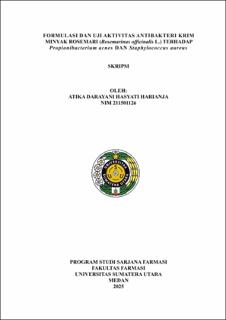Formulasi dan Uji Aktivitas Antibakteri Krim Minyak Rosemari (Rosemarinus officinalis L.) terhadap Propionibacterium acnes dan Staphylococcus aureus
Formulation and Antibacterial Activity Test of Rosemary Oil (Rosmarinus officinalis L.) Cream Against Propionibacterium acnes and Staphylococcus aureus

Date
2025Author
Harianja, Atika Darayani Hasyati
Advisor(s)
Nazliniwaty
Metadata
Show full item recordAbstract
Acne (Acne vulgaris) was a common skin problem. One of the natural ingredients that had been used to overcome this condition was rosemary oil. Rosemary oil possessed antibacterial activity that could protect the skin from Propionibacterium acnes and Staphylococcus aureus. In this study, rosemary oil was formulated into a cream to facilitate its application on the skin. This study aimed to formulate a rosemary oil cream preparation that met the quality evaluation requirements and to observe its antibacterial activity against Propionibacterium acnes and Staphylococcus aureus. The research method included antibacterial activity testing of rosemary oil and formulation of cream preparations with concentrations of F0 (blank), F1 (5%), F2 (10%), and F3 (15%). The quality evaluation of the cream preparations comprised organoleptic testing, homogeneity, pH, viscosity, spreadability, emulsion type, cycling test, and stability at room temperature for 12 weeks. The antibacterial activity of the cream preparations was tested against Propionibacterium acnes and Staphylococcus aureus. The formulated rosemary oil cream preparation demonstrated good physical characteristics, including homogeneity, an oil-in-water emulsion type, a pH range of 6.22–6.31, viscosity ranging from 5,834.67 to 8,576.00 cP, and a spreadability range of 5.17–6.73 cm. The cream was also stable during 12 weeks of storage and after cycling tests. The antibacterial activity test showed that the rosemary oil cream exhibited activity against Propionibacterium acnes with inhibition zone diameters of F1 (5%) = 18.40 mm, F2 (10%) = 23.23 mm, and F3 (15%) = 24.20 mm. Meanwhile, against Staphylococcus aureus, the inhibition zones were F1 (5%) = 15.93 mm, F2 (10%) = 20.57 mm, and F3 (15%) = 24.30 mm. Rosemary oil cream (Rosmarinus officinalis L.) at a concentration of 5% exhibited strong antibacterial activity, as indicated by inhibition zone diameters of 15.93 mm against Staphylococcus aureus and 18.40 mm against Propionibacterium acnes.
Collections
- Undergraduate Theses [1833]
